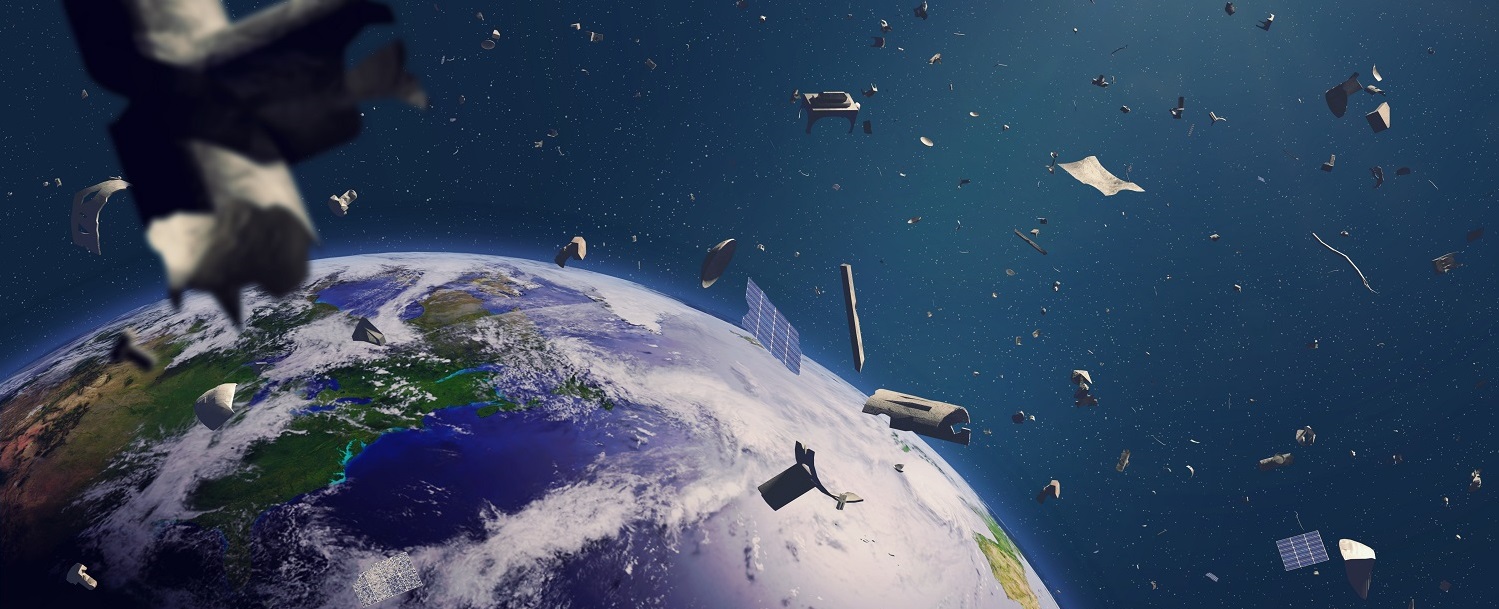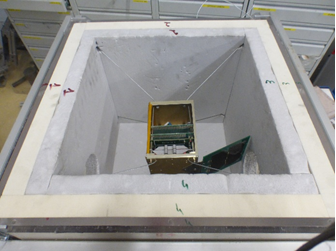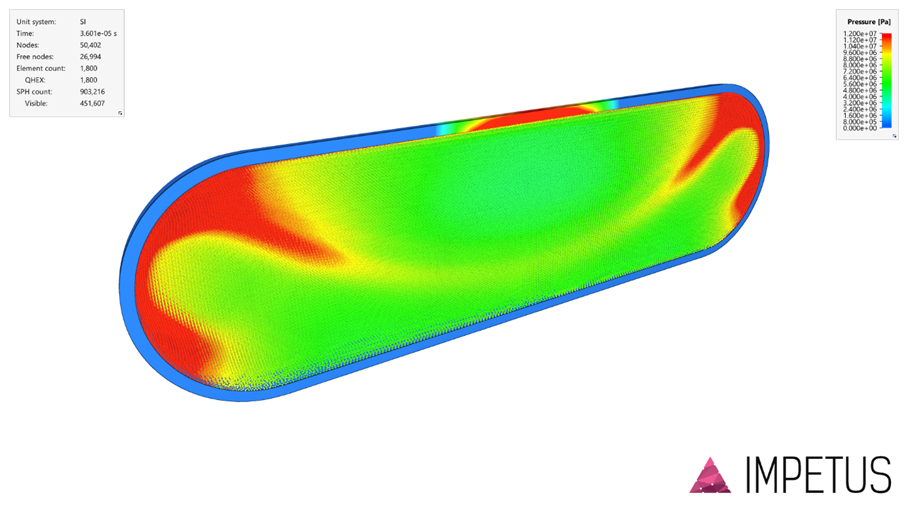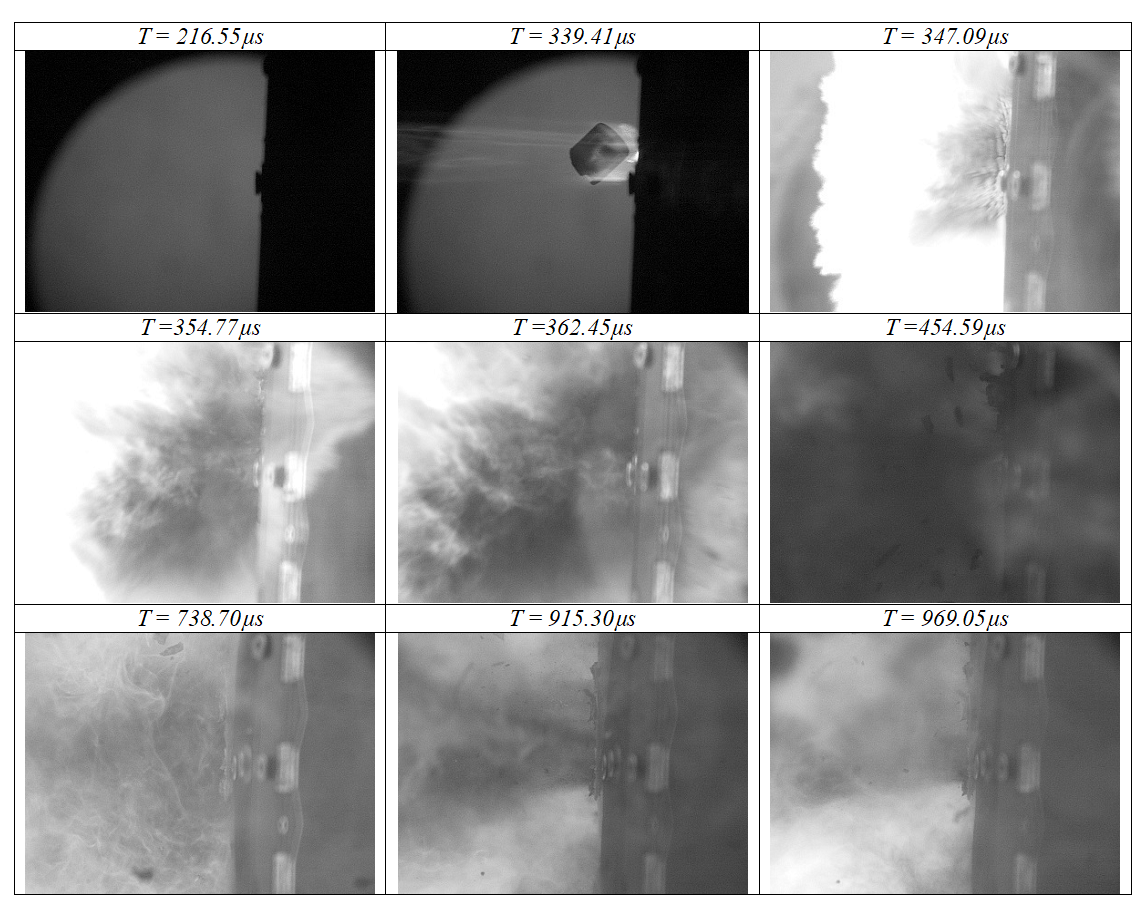
The study of orbital debris, and more specially their impacts when they collide with structures in orbit, is a major issue for space agencies. Space structures generally use Whipple shields made up of two separated sheets as protection from impacts with orbital debris. Such shields perform better than a single plate with the same density for impact speeds higher than 6km/sec. During an impact of debris, the threat is addressed in two steps: the first wall, known as bumper, first disintegrates the projectile so that the debris generated on that first impact can be easily stopped by the second wall.
The velocity of orbital debris ranging from 8 to 14 km/sec (Hypervelocity), there currently are no experimental setups that can help reproduce such impacts in a laboratory at speeds over 10 km/sec. The size of protection shields of space structures is determined by using both experimental and digital means. First, impact trials are carried out within the speed limits that can be reached in a laboratory (up to 10 km/sec in our laboratory). A numerical model, combined with data collected during the experimentations, is used to extrapolate the results to higher speed. The result of this process is generally the definition of Ballistic Limit Equation (BLE) which defines the evolution of the critical diameter of the debris that can lead to the perforation of the protection according to the impact speed.
In 2014, Thiot Ingénierie and CNES (France Space agency) started a collaboration with the objective of implementing that process to analyze the impacts of hypervelocity on representative structures (pressure tanks, sandwich panels, etc.). More precisely, Thiot Ingénierie has participated in / started three hypervelocity studies related to the issue of orbital debris.
Study of Multi-Layer Insulation (MLI) structures
The first study is designed to assess the performance of MLI type insulation layer. MLI is a structure made up of fine layers of various materials such as kapton, aluminized Mylar, polyester… It is used to cover space structures, it is what gives space vehicles the appearance of being covered by a gold leaf. Its main function is to reduce heat loss caused by infrared radiation. That main function of external cover exposes MLI to impacts of debris, thus justifying their use as bumper in a solution of shielding from impacts of hypervelocity. The behavior of MLI against the impact as well as its capacity to break down debris are still to be clearly established. In what have been said so far, two types of ballistic equations are proposed to estimate the capacities of MLI in that configuration, but the gap between these two models is quite important in the speed range taken into account, thus the necessity of additional experimentation.
The objective of this study is to identify, through hypervelocity impact testing, the ballistic equation model that best reproduces how an MLI behaves as a bumper. For that purpose, we have considered a double wall target with an MLI bumper and an aluminum rear plate. Orbital debris are represented by an aluminum ballpoint, which runs into the target under study at a speed comprised between 4 and 9 km/sec. A total of 12 trials were conducted with 5 of them at a speed higher than 8 km/sec.
Phenomenologically, the nature of the ballpoint after impact with the MLI mattress depends on the speed of impact. We essentially have big debris with low speed (4.5 km/sec). Then, with intermediary speed (6 km/sec) the size of fragments decreases while their number increases. Around 8 km/sec, a great chunk of the ball point melts at the moment of impact with the MLI.

Representing experimental results according to the diameter and speed of the ballpoint

Visualizing a hypervelocity impact on an MLI. 1 mm ballpoint at 8 km/sec.
This result is the same we have with an aluminum-aluminum double wall. The evolution of the critical diameter of the perforation according to the speed of impact can be framed by taking into consideration both perforating and non-perforating trials. The results helped us come to the conclusion that one of the models is very conservative (SRL) across the entire range considered.
Other models overestimate the protective power at low speed (up to 5.0 or 5.5 km/sec). Around 6 km/sec, the last two models predict a critical diameter of perforation that is close to experimental results. However, the two models are slightly conservative around 8 km/sec. Speed limits which limit the three characteristic regimes of a double wall were not clearly identified given the limited number of trials, but the points that have been recorded align with those that are used in an SRL model.
Assessment of the vulnerability of a nanosatellite
The second study is integral part of a project which goes in line with the CNES’ Tech4SpaceCare initiative. The project consists in combining laboratory trials with numerical simulations in order to analyze the consequences of a catastrophic collision between orbital debris and a nanosatellite. The number of nanosatellites in orbit is continuously growing; therefore, it is crucial to know which debris they can generate, either due to the explosion of an internal source of energy, or an explosion resulting from an impact with debris in orbit. Fragmentation models are generally used, the most popular having been developed by NASA. An update is however needed in order to include those nanosatellites and the material they contain. This adaptation requires experimental laboratory results, which are being carried out in this study.
Thiot Ingénierie have conducted a hypervelocity trial with a 0.72 g-projectile, projected at 6700 m/sec on a nanosatellite of 150x100x100 mm3. That version had four batteries, electronic cards, flywheels, a solar panel and a thermal blanket. The satellite was stationed in a specific impact room, with an inner cover made of specific foams that would help collect the debris generated by the impact. The energy of impact was defined so as to generate enough damage and debris, without totally destroying the satellite.

Internal components were greatly damaged and the impact on the batteries and the thermal blanket generated many small-size fragments. The impact chamber was later transferred to the company R.TECH, in charge of identifying the fragments, where they will be weighed and measured with the help of a 3D video camera; the process is still going on but that should help CNES make a significant move forward in the modeling of such phenomena!
Validation of a model of hypervelocity impact on reactive fluid tank

Hydrazine is used as fuel for satellite propulsion. In some cases, tanks containing that highly reactive fluid can be exposed to impacts of space debris. In the most favorable case, the tank can simply be perforated, which leads to fewer secondary debris. On the contrary, if the energy brought in by the impact is sufficient enough to induce a reaction of hydrazine and lead to the explosion of the tank, then there will be a significant amount of debris generated. In 2019, CNES initiated a study on modeling such fluid with the company IMPETUS AFEA. This model helps describing the behavior of such fluid after an impact and determine its explosion limit. It was developed with the aim of determining risks of explosion of the hydrazine tank of a satellite in the event of an impact with orbital debris.
The current study, which started in 2020, consists in conducting hypervelocity impacts on a tank containing hydrazine and a neutral gas (helium or nitrogen) at various proportions. The trials will be instrumented to collect data on temperature and pressure for the adjustment of the model. The study started with a safety study aimed at evaluating the risks in handling that CMR product (carcinogenic, mutagenic, and reprotoxic…). Based on that study, we are designing a management and passivation system of that product so that our collaborators can work safely. We are working in close collaboration with ArianeGroup who provides us with their experience on those aspects.

The next steps will be the manufacture of the entire system and hypervelocity impact testing. Finally, a comparison with the model and a final calibration will be made. A whole program for 2021…
